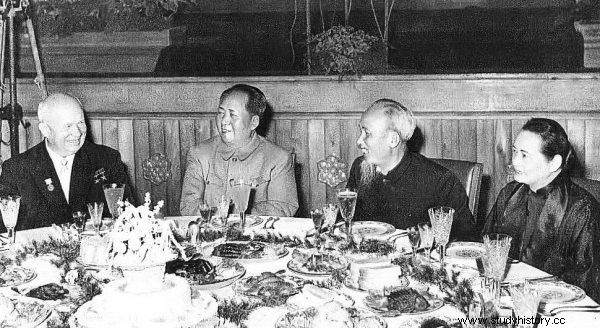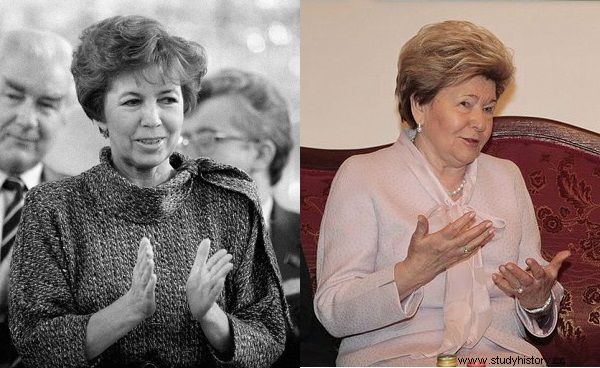Brezhnev was a terrible goblet, Gorbachev even freaked out at breakfast and Yeltsin drank plain vodka with buckets. What secrets did the Kremlin kitchen hide and hide?
Włodzimierz Lenin paid little attention to food, and he openly called lunch and dinner "feeding". The leader of the revolution had to think about the future of all mankind, and not deal with such mundane matters as cooking! Apparently he couldn't even serve his favorite dishes. The fact is that the first Bolsheviks ate modestly:rare soup, porridge and tea. The only extravagance Vladimir Ilyich allowed himself was a mug of good beer. Lenin was born in Symbirsk on the Volga (currently Ulyanovsk), which is still famous for its great brand of Żygułowskie beer. Besides, he stayed for a long time in Germany, England and Switzerland, so he got to know good beers perfectly.
A feast in Georgian with Stalin

Joseph Stalin raises a toast. During Kremlin feasts he was drinking glasses of fine Georgian wine.
Joseph Stalin, who grew up in Georgia, where long feasts are part of the tradition, had a completely different approach to the pleasures of the table. During his term in office, excellent Georgian wines, cheeses, sweets, beef and lamb dishes began to appear on the Kremlin tables. Stalin was also served a Siberian fish nelma, which he had met in exile. Later it was delivered to Moscow by special planes. The nelma was used to prepare stroganin (specific Siberian carpaccio) and the ear, or fish soup.
Stalin had some strange habits. First, the waiters at the parties had to leave the room immediately as soon as they had brought all the dishes. This is because the parties discussed matters of national importance. Secondly, each of the party dignitaries had to try the first course. Usually, it was usually started with szczi (various variations of cabbage soup) or charcho (Caucasian rice, tomato and mutton).
Reception with Stalin lasted until dawn. Guests had plenty of snacks at their disposal:pork loin, roulades of mutton or poultry, sturgeon and sterlet, dumplings and pies, stuffed fish, skewers, Georgian phali with nuts and eggplants, czanachi, łobio. Stalin himself ate little, usually one tomato or a dumpling was enough for him. He drank the blame for this (delicious Georgian wines with the favorite Tsinandali and Teliani). It was probably under his influence that he forced his guests to overeat and try all the dishes. The bar served more than 10 types of vodka and brandy (including the famous Kizlar, sent as a gift to Churchill). The most exclusive desserts back then were the mini-bananas, and the red car appreciated the fruit.

Khrushchev liked to surprise his guests with national dishes. When an exotic delegation came, Kremlin chefs often had to prepare snakes and insects.
Khrushchev cannot hide meat…
In turn, Nikita Khrushchev did not eat much fruit. He was a lover of meat in various forms:stuffed with mushrooms, stuffed with sweet and sour plums, sirloin in 100 ways. He also liked dumplings with cabbage and onions, cottage cheese and cream, potatoes and cherries. But his mouth water was the most drooling at the sight of the hunting stew. For dessert, the Kremlin bakery provided him with delicious cookies.
Although Khrushchev was born in Russia, he spent his youth in Donbas, Ukraine. During his reign, the Kremlin cuisine underwent a significant change. Khrushchev introduced many Ukrainian dishes to the menu, including hot vodka with paprika. He also attached importance to the quality of the ingredients. Nikita, quite primitive in his workings, started to celebrate foreign guests with their native dishes, e.g. for the Chinese leader, cooks cooked and fried pythons, mice, snails ...
For Brezhnev the food was poured out
During the reign of Leonid Ilyich Brezhnev, there was a real culinary debauchery. The chief was not pleased if the table literally did not sag under the weight of the food. Leonid was a big goblet. In his time, cooks worked tirelessly. Among other things, lobster soup has returned, a great delicacy among wealthy Russians from the Tsarist era . Party plates were decorated with roses made of fresh cucumbers and tomatoes. The dishes had standard names, but their recipes differed significantly from those eaten by the people.

Brezhnev, Khrushchev and Yuri Gagarin during the Kremlin feast.
For example, the vegetable Olivier salad was prepared according to a 19th-century recipe of crab meat, quail eggs, bacon and homemade mayonnaise in olive oil . In Stoliczna salad, green peas were replaced with pineapple, and lamb's tongues were poured over with jelly. Red and black caviar were served in special frozen cups. After the appetizers, some gigantic main course was brought, such as a large stuffed sturgeon or a piglet. All the bones and bones (depending on the species) had to be skillfully removed from the animal, seasoned, stuffed and baked, and then restored to its original form.
This article has more than one page. Please select another one below to continue reading.Attention! You are not on the first page of the article. If you want to read from the beginning click here.
Hunting was Leonid Ilyich's passion, where each participant received a packet of not so dry provisions:250 ml of brandy and sandwiches. Besides, Brezhnev liked Poles (he spoke Polish well) and he also liked our Żubrówka!
First ladies give cooks a nice school!
Mikhail Gorbachev was terribly capricious. Of the various dishes, he ate only small portions because he was afraid to get fat. Apparently, he could try 5 types of porridge for breakfast. The best, from wholemeal pearl barley, was cooked for 8 hours. If he ate grapes, it was only seedless. At parties he preferred mutton, venison, sturgeon and his crosswords baked in… champagne. Mikhail's wife, Raisa Gorbachev, forced him to send cooks and waiters to practice in England and generally contributed to the Europeanization of Russian cuisine. She also paid close attention to the appropriate setting and decoration of dishes. She herself enjoyed coffee with a very high crema.

Two more first Kremlin ladies have taken its cooking crew into gear. In the photo on the left Raisa Gorbachev (photo published under the license CC-BY-SA 3.0, RIA Novosti archive, Vladimir Akimov), on the right Nain Yeltsin (photo published under the license CCA 3.0, author:www.kremlin.ru).
Borys Yeltsin liked the most… pure vodka with pickled cucumbers. He was known for his taste for drinking alcohol, although Kremlin chefs mention that Gorbachev also had a strong head. Yeltsin did not change much on the menu, but chose the simplest of dishes. He eagerly consumed cucumber soup, borscht, cabbage soup and dumplings with a lot of stuffing. And of course, as befits a real Russian, plenty of venison. Yeltsin was from the Urals. The most famous dish from there is pielmieni - small dumplings with various stuffing. The first lady, Naina Yeltsin (an excellent cook herself) was teaching the Kremlin cuisine to cook pielmieni with two kinds of meat stuffing.
Soviet cuisine for sophisticated, foreign palates

The English iron lady was convinced by the Kremlin cuisine ... pancakes! (photo published under license CC-BY-SA-3.0 by Rob Bogaerts)
The Kremlin menu satisfied the most demanding palates. Margaret Thatcher, during her visit to the USSR, initially ate only food provided by the British embassy.
One day, Kremlin waiters persuaded her to try pancakes. Apparently she ate all available in the kitchen at the time.
The Kremlin's cuisine was also enchanted by Indira Gandhi, who liked to take her son and her daughter-in-law with her on delegations to the USSR. Foreign guests often lived in villas in Worobiowe Góry (then Leninowskie Mountains).
Every morning Indira's daughter-in-law went to a nearby market to buy cornflowers and decorate rooms with them. Indira herself loved Russian soups, especially homemade duck broth with homemade noodles. She personally wrote down a recipe for it.
Over the years, the Kremlin's menu has changed many times. However, the security procedures practically did not change. All kitchen workers were also collaborators of the security services. Guests were marked with individual numbers.

Indira Gandhi took her family to Russia and was delighted with the Kremlin cuisine.
Traditionally, each new dish has come a long way to acceptance. The evaluation was made by a commission composed of cooks, product suppliers, technical staff, etc. The samples were collected by the doctor in a solemn atmosphere and in the presence of all staff. God forbid one of the workers didn't wash their hands - they would be fired right away!
